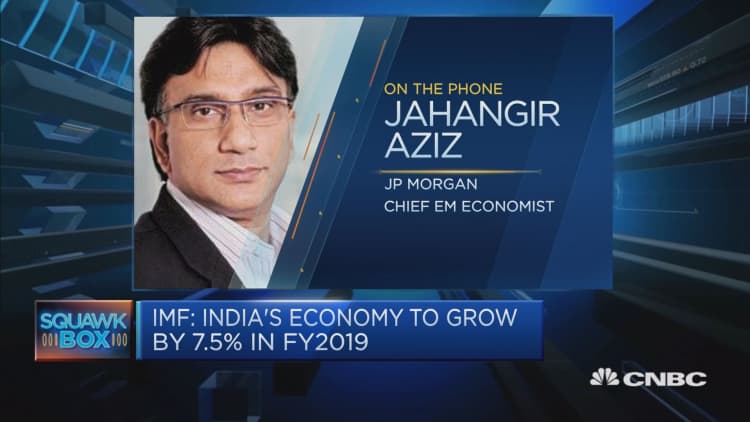Against the backdrop of a global slowdown in growth, spurred by China, India's economic performance is being closely watched by investors.
India is set to announce an interim budget on Friday that's expected to reinforce economic support, especially in the flagging agricultural sector, and still keep government spending under control.
While experts said they were not expecting sweeping changes in Friday's budget, they predicted the government would likely announce measures to help farmers, low-income households and micro- to medium-sized businesses.
Fiscal targets
Investors will be looking at whether the Indian government's fiscal consolidation is on track, based on deficit targets it announces for fiscal 2019 and fiscal 2020, Radhika Rao, an economist at Singapore's DBS Group, told CNBC. India's fiscal 2019 will start on Apr. 1.
"In light of growing spending pressures … this deficit target will rest on ambitious revenue and growth targets, reviving the quantity vs quality of consolidation," she said.
Analysts expect the government to set a deficit target anywhere between 3.2 percent to 3.5 percent of GDP for fiscal 2019.
Investors will likely glean the budget for projected sources of revenue, to see how expenditures will be met if the government lines up relief packages for farmers and small-to-medium businesses. A shortfall could potentially dent investor confidence since a widening government deficit could lead to a revision of India's creditworthiness.
Revenue from goods and services tax (GST) so far has mostly fallen short of the government's monthly target, according to media reports.

Meanwhile, efforts to raise money through divesting state-owned assets were not entirely successful either.
A key focus would be whether India can meet its disinvestment target of 800 billion rupees (about $11.2 billion), said Sanjay Mathur, chief economist for Southeast Asia and India at ANZ. "Because so far, they are way behind that," he added.
The government had raised only 42.7 percent of the 800 billion it originally planned by November, according to reports.
Another source of revenue could be an interim dividend from India's central bank, which could boost the government's finances temporarily.
However, ratings agency Moody's warned that any positive impact from that move would be short-lived.
"Achieving deficit reduction through such unpredictable revenue sources denotes weaker fiscal policy effectiveness than if consolidation were achieved through more durable and predictable revenue sources, such as tax revenue," analysts at Moody's Investor Service said.
Cash for farmers
Investors will likely be looking at how much the government will be spending to support farmers, who make up a sizeable portion of India's workforce.
Farmers have been struggling for years due to low crop prices, rising costs, demonetization and widespread droughts.
Typically, India has given farmers loan waivers to help ease their financial burden. Other measures to support farmers' incomes are being considered at a national level and could be introduced in Friday's budget. That includes cash transfers that are already in place in some states where the local governments given farmers a fixed sum of money yearly for every acre of land they own.
"The final scale and shape of the scheme could vary, but we believe that the government is likely to rejig the manner in which the farm sector is currently supported — implying that some of the existing input subsidies are subsumed to fund the direct income transfer scheme," Upasana Chachra, chief India economist at Morgan Stanley, wrote in a recent note.
If the scheme were to focus only on small and marginal farmers, it could cost India an estimated 0.7 percent of its GDP, Chachra said.
Support for businesses
Consensus among experts is that the budget could introduce some relief measures for India's micro, small and medium businesses.
Such companies have struggled in recent years to obtain loans amid increased competition, and strict factory regulations. They were also hard-hit by the 2017 rollout of the GST.
Some of those measures could include subsidized bank loans, insurance, and pensions, "which would most likely be administered through India's state-controlled insurers and struggling state-controlled banks," Sasha Riser-Kositsky, senior analyst at Eurasia Group, wrote in a note last week.


